Pierre-Henri de Valenciennes
Pierre-Henri de Valenciennes (December 6, 1750 – February 16, 1819) was a French painter who was influential in elevating the status of open-air painting.
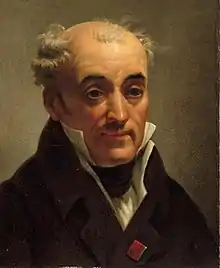
Life & work
Valenciennes worked in Rome from 1778 to 1782, where he made a number of landscape studies directly from nature, sometimes painting the same set of trees or house at different times of day.[1] He theorized on this idea in his 1800 treatise Reflections and Advice to a Student on Painting, Particularly on Landscape, developing a concept of a "landscape portrait" in which the artist paints a landscape directly while looking upon it, taking care to capture its particular details.[1]
Painting outside allowed Valenciennes to capture the fleeting changes of a landscape due to light and weather. He was a proponent of artists working outside and painting the same view at multiple times of day.[2] Although he spoke of this as a type of painting mainly of interest to "amateurs",[3] as distinguished from the higher art of the academies, he found it of great interest, and of his own works the surviving landscape portraits have been the most noted by later commentators.[1]
He in particular urged artists to capture the distinctive details of a scene's architecture, dress, agriculture, and so on, in order to give the landscape a sense of belonging to a specific place; in this he probably influenced other French artists active in Italy who took an anthropological approach to painting rural areas and customs, such as Hubert Robert, Pierre-Athanase Chauvin and Achille-Etna Michallon.[3]
Among his students were Jean-Victor Bertin, Achille Etna Michallon, Louis Étienne Watelet, Louis-François Lejeune and the first French panorama painter Pierre Prévost.
Born in the city of Toulouse, he died in Paris and is buried there in the Père Lachaise Cemetery.
Gallery
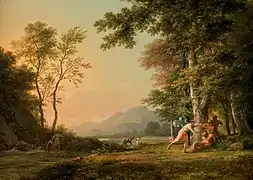 A Wooded Landscape with a Bacchic Scene circa 1810
A Wooded Landscape with a Bacchic Scene circa 1810 View of the Environs of Rome
View of the Environs of Rome A Capriccio of Rome with the Finish of a Marathon 1788
A Capriccio of Rome with the Finish of a Marathon 1788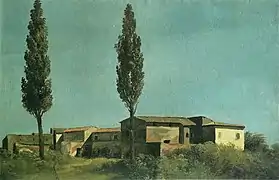 At the villa Farnèse : two poplars
At the villa Farnèse : two poplars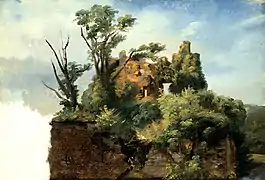 Landscape with Ruins circa 1782-1785
Landscape with Ruins circa 1782-1785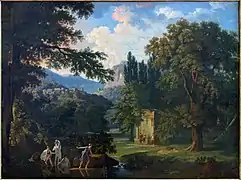 Historical Landscape circa 1800
Historical Landscape circa 1800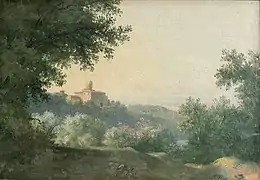 View of the Palace of Nemi. circa 1780
View of the Palace of Nemi. circa 1780
References
- Joshua C. Taylor (1989). Nineteenth-Century Theories of Art. University of California Press. pp. 246–247. ISBN 0-520-04888-1.
- Andrews, Malcolm (1999). Landscape and Western Art. New York: Oxford University Press. p. 191. ISBN 0192100467.
- Matthew Craske (1997). Art in Europe, 1700-1830. Oxford University Press. pp. 115–16. ISBN 0-19-284206-4.